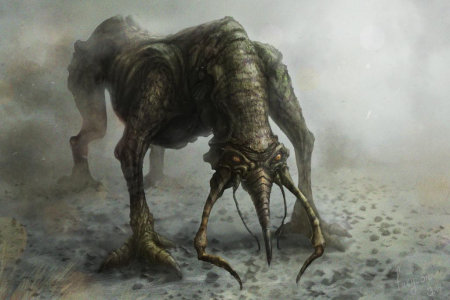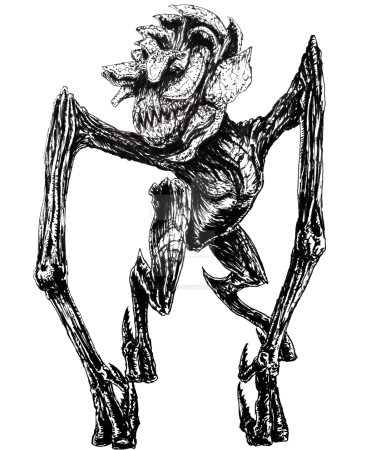Ghaalb
The Ghaalb (Derived from Ghabar meaning Dust, and Kalb meaning hound in Arabic), is a strange creature being that is presumed to be the byproduct of the crossing of an anomaly with a pack of displaced wolves. However, this assumption is rather common place as that tends to be the assumed cause of all things strange and abnormal. Whether they were a creature of the Barrens that were simply undiscovered in previous days, or a new creation, they have been proven to be extremely useful in the settlement of the vast desert. Being six legged with a beetle like carapace, they are able to easily traverse the deserts of the the Barrens whether that be on the surface of the sands or by digging beneath them with wide and sharp edged claws. Their capacity to easily vanish beneath the sands is quite extraordinary. They have ant like mandibles with which they can cut and chew through most objects, even being known to bite through chain mail though with some difficulty. Along their body they have a series of antenna, three upon their head, three upon their shoulders and three along their spine. Largely being blind, especially during the day, they navigate through smell, and through vibrations both through the air and earth, and also seem to have a capacity for thermal vision, explaining why they prefer to hunt at night. Finally, the last detail about them is their carapace. The carapace does not easily release heat, and so, through many segments along their body, they are able to open up their carapace revealing their softer tissue inside. They only do this when they are protected from both wind and enemies, for opening their carapace causes them to become vulnerable both to predators and debris, primarily sand. Thus, opening their carapace is generally a sign of either friendship, though an opening and a rattling of carapace signals hostile intent.
Basic Information
Anatomy
A creature largely representing a cross of an Ant and a beetle. It has has three hearts, and three stomachs, and three eyes. The hard carapace is segmented and is able to be raised up to release heat and attempt to intimidate foes, or sealed shut for protection. The Ghaalb has nine antenna, three on the head, three on the forward shoulders and three along the spine. They have powerful forward facing 'arms' that end in a series of wide and sharp claws, useful for both digging and fighting, especially finding chinks in other Ghaalb's carapace and peeling it open. Despite their size they are rather light, allowing them to move quickly across the desert sands.
Genetics and Reproduction
Being insectile in nature they function with one queen that births the majority of them, though there are other female Ghaalb around. Each year, the male Ghaalb fight in front of the Queen, in a somewhat organized and structured competition which only the strongest and most durable male wins. At that point, that male Ghaalb is allowed to mate with the Queen, at which point it deposits the majority of it's reproductive organs inside the queen, for her to assimilate into her own organs. These are sufficient for fertilizing all her eggs, which begin to grow up and out of the back of her carapace. This process will ultimate kill the 'Queen' as the eggs parasitically consume all the neutralists from her body. During the gestation period, the chosen male will, though infertile, mate with as many of the other females in the pack, until he chooses the new queen, the one that is strongest and is determined to be able to produce the highest quantity of eggs. After a new queen is chosen, the male will return to the pregnant queen, and be devoured by her to bolster her as she enters the last stages of pregnancy. She dies shortly before the egg sack bursts, and the larva are born. Devouring the queen and their semi digested father, they incubate for approximately a year in various corpses.
Growth Rate & Stages
It generally takes around nine years for a Ghaalb to reach full maturity, though they begin to contribute to hunts by the age of three. Their first stage of life is their Larva Stage, as they reside inside and consume the corpse of their mother and father. Other Ghaalb will bring corpses to the larva for further feeding. After the first year, they develop into functional though very small Ghaalb. The second and third year, they enter their Growth Stage as they are nurtured and taught by other Ghaalb how to function in life, learning social interactions and hunting techniques. Between their third and sixth year, they enter their adolescence, in which they begin to partake in hunts and nest construction, learning how best to support the colony. The final stage is maturity, The Pilgrimage, is where several Ghaalb will leave in a group and travel for approximately three years until they have either died off or successfully created another colony. Through this process, one might assume that there are thousands upon thousands of Ghaalb. However, that is not the case. There are numerous places along their development where many Ghaalb die. Being cannibalistic in nature, it is not uncommon for the weaker and least successful Ghaalb to be eaten by their brothers and sisters. This culling takes place from the larva and runs throughout their whole life. If one becomes injured and might be left behind, they instead eat the injured one. Additionally to this, there are often many growth defects, such as delayed shedding of old shells, which greatly hinder's one's ability to grow, or where the carapace will become fused together, causing the Ghaalb to either become deformed or to literally burst out of it's own shell killing it.
Ecology and Habitats
They live largely in underground nests in the sands of the Barrens.
Dietary Needs and Habits
They are omnivores and will eat anything they can get their mandibles on. However, they prefer meat and will rather hunt than forage.
Additional Information
Social Structure
They are predominantly matriarchal and the chosen queen each year leads and commands the colony. However, outside of mating season, there is little recognizable differentiation between males and females each being of the similar color and size. The largest proponent tends to be under their carapace, as different hues and patterns are more common on one gender than the other, however, it is not a hard set rule.
Domestication
They have been domesticated in small portion by the Kingdom of Umar. At least, they are commonly found in cities and the like, and are frequently used throughout the kingdom. However, the species remains predominantly wild. Farmers will frequently use them as livestock, harvesting their discarded carapace for the construction of many items ranging from tools, house tiling and armor, and the farmers will harvest them for food as well. The strongest among the Ghaalb are often sold to the Military for training purposes, being keen hunters and of quite some intellect, they have proven to be a valuable addition to scouts and skirmishing groups. The trade of nests is highly valued, but difficult, as where a Female will decide to mate, is where the Ghaalb will consider home. Therefore, the only way to relocate them, is to take the chosen female before she breeds, and relocate her, and the whole pack will follow. However, they tend to follow with extreme hostility, only understanding that their new queen is in danger, and so the sale of nests is dangerous, difficult and expensive. However, once a nest is created, maintaining it is relatively easy. The domesticated ones will not feel the need to hunt if fed, and those that are about to go on their pilgrimage can be either killed for food or taken away for training. Maintaining their population becomes rather easy.
Average Intelligence
About as intelligent as a child. It can understand intent, desire and some complex instructions, even being able to communicate in some form.
Perception and Sensory Capabilities
The antenna which line their body are able to detect vibrations in the earth and scents on the wind. Additionally, though the full extent is not known, they are able to see thermal signals, making them almost blind during the day, but exceptional hunters in the night.
Lifespan
40 years
Average Height
On six legs their shoulders stand around two and half feet high, though when standing on their hind legs, they can be as tall as six feet.
Average Weight
Around 50lbs
Average Length
Four feet
Body Tint, Colouring and Marking
Most often their carapace is an earthen color, being of light tans and grays. Under their carapace however, they vary from a vibrant red to a purple.





Comments